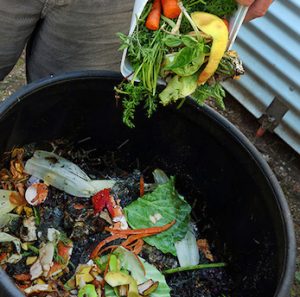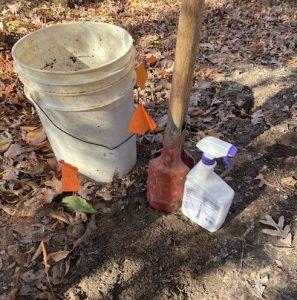Small Scale Pit Composting
By Ernest H. Ruckert, III, Fairfax Master Gardener Composting. You have heard about compost piles and may even have one in the backyard for yard waste. What about vegetative food waste (food scraps or Source Separated Organic Waste (SSOW) as it is referred to in the solid waste industry)? Europeans are required to keep food waste separate from other waste and place it separately at the curb for collection. We will likely be required to do the same in the future.
Composting. You have heard about compost piles and may even have one in the backyard for yard waste. What about vegetative food waste (food scraps or Source Separated Organic Waste (SSOW) as it is referred to in the solid waste industry)? Europeans are required to keep food waste separate from other waste and place it separately at the curb for collection. We will likely be required to do the same in the future.
Here is another composting method. Consider having a compost pile for yard waste and a separate pit composting area that is used for vegetative food scraps. The composting takes place underground, which is out of site from small animals, compared to most other types of composting which are aboveground. There is little information on pit composting, and it is not suitable for everyone’s situation. From my perspective, it is relatively easy, requires minimal labor and time, is small scale and largely out of view. It does require some getting used to — the storage of the vegetative scraps and digging the pits (holes). However, the compost product is well worth the effort.
 You need to plan for the storage of the source separated organic waste in the kitchen or garage, prior to placing the material into the composting area outside, and for cleaning out the reusable container for the next round of SSOW. Many container styles, configurations and material types are commercially available either at retail stores or online. Or you can use a large coffee can with a plastic lid and insert a plastic food storage bag inside the can. If the can has no plastic lid, be sure to use a zip lock bag, a twist tie or fold over the top and use a binder clip to keep the bag closed to control some odors and minimize the potential for fruit flies. Two adults can produce approximately the volume of two one-gallon milk jugs of SSOW per week.
You need to plan for the storage of the source separated organic waste in the kitchen or garage, prior to placing the material into the composting area outside, and for cleaning out the reusable container for the next round of SSOW. Many container styles, configurations and material types are commercially available either at retail stores or online. Or you can use a large coffee can with a plastic lid and insert a plastic food storage bag inside the can. If the can has no plastic lid, be sure to use a zip lock bag, a twist tie or fold over the top and use a binder clip to keep the bag closed to control some odors and minimize the potential for fruit flies. Two adults can produce approximately the volume of two one-gallon milk jugs of SSOW per week.
Types of organics to compost can include vegetable and fruit peelings, eggshells, coffee grounds (paper filters are OK) and spoiled vegetables and fruit. Meat, fish, fat or bones should not be included. Due to the relatively small size of the pits, yard waste cannot fit into them. An adjacent compost pile would be beneficial for yard waste.

New Pit
Let’s construct the pit. There is minimal work, as you dig a hole (pit) with a shovel or post-hole digger down approximately 12 inches (30 cm). The surface area of the hole is based on how much organic material you will place into the hole and still have enough room to cover the material with 4 to 6 inches (10-15 cm) of soil. The soil cover helps to keep animals from digging up what you have placed into the hole, although the vegetative scraps generally do not attract animals. As a precaution, we spray an animal deterrent, the type that has capsaicin, a natural irritant, on top of the soil cover to keep animals from digging into the pit. Or you can also make your own with placing several hot peppers into a gallon jug of water and keep the mixture bottled up for a while prior to use.

Finished and sprayed
After you have completed the hole, mark out the edge of the hole so you can make the next pit adjacent to the previous pit, which could likely be within a week. Depending on the biological and earthworm activity, dig into the pit with a trowel in approximately six months’ time to determine if the organics have degraded. Note that the eggshells will not have decomposed, and that is OK. If you dig up humus-like material, you are done; if not, cover the hole back up and let nature work on it for some additional time. As this is a biological process, there is a range of time for the vegetative waste to compost process to be completed, and this cannot be predicted with any certainty.
If you are up for a small challenge, give this composting technique a try. It should be well worth the effort.
…updated 2024
-
Resources
- Small Scale or Backyard Composting, Cornell Waste Management Institute
- Earth-Kind Landscaping, Chapter 3, Composting Structures, Texas A&M AgriLife Extension
- Composting Methods, University of Florida, IFAS Extension